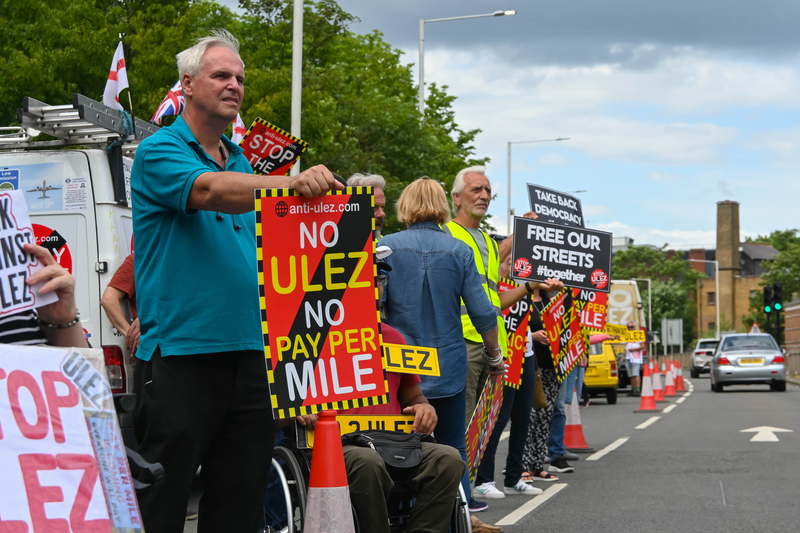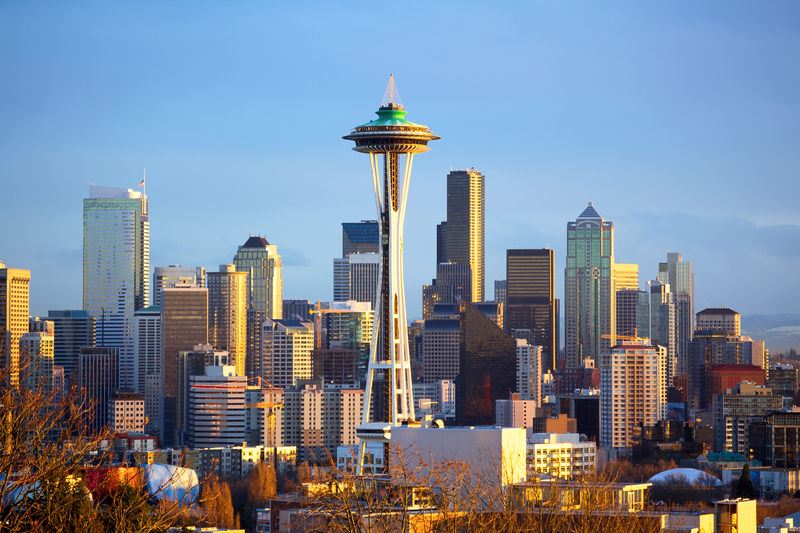
At the International Bridge, Tunnel and Turnpike Association (IBTTA) Annual Meeting & Exhibition in the US city of Seattle last October, ITS International toured the State Route 99 tunnel. Also called the Alaskan Way Viaduct replacement tunnel, SR99 is in the centre of the Pacific coast port city in the north-west state of Washington.
The 3.2km-long double-deck bored tunnel carries a section of SR99 under the city centre, following closely the old Alaskan Way viaduct alignment that used to carry SR99 and which ran close to the city’s waterfront. Structurally, it is a masterful piece of engineering, being an efficient mover of vehicles in a safe fashion.
The tunnel opened in 2019 and for a brief period was not tolled. But when charges were introduced, usage dropped and then Covid hit, further depressing tolling revenue. Shutdowns and lockdowns and the lack of travellers hit most major US transportation facilities hard and traffic-level recovery has been slow for some - including the SR99 tunnel.
Its variable-rate tolling changes based on time of the day, number of vehicle axles and payment method. Tolls are collected electronically, with a lower rate for holders of a Good to Go pass and a higher rate for other drivers where the tunnel system scans their vehicle licence plates and they are sent an invoice in the mail.
According to the Washington State Department of Transportation (WSDoT), tolling the SR99 tunnel helps repay $200 million borrowed to build the structure. It also pays for the ongoing cost of operating and maintaining a safe facility. This funding is part of the $3.3 billion construction cost to replace the ageing Alaskan Way Viaduct and rebuild SR99 through Seattle.
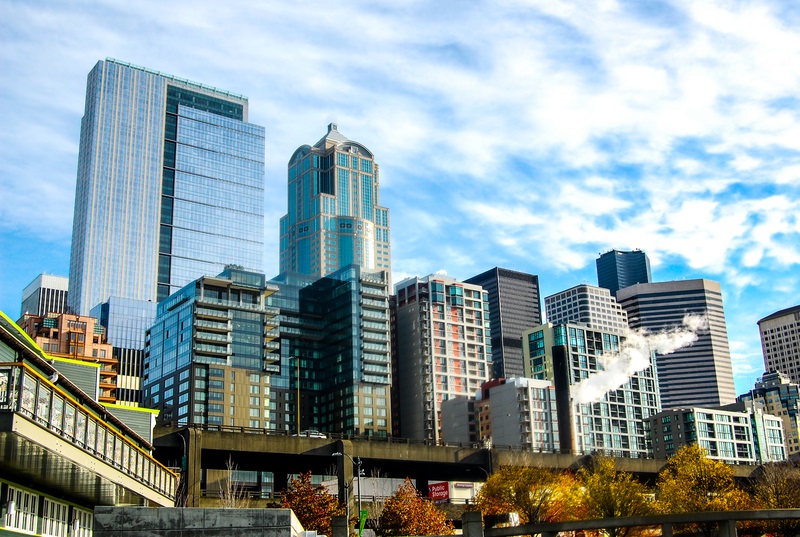
Tolling optimism
The recently published 2023 Annual Tolling Report from the Washington State Transportation Commission highlighted the issues facing infrastructure construction repayment and the financing of maintenance and operation. As Washington state’s tolling authority, the commission is responsible for setting toll rates and polices for all tolled facilities statewide. It noted that it must take action to close the projected SR99 tunnel funding gap.
Total revenues for all five tolled facilities for which the commission is responsible dropped 22.8% below the pre-Covid forecast. Revenue for the SR99 tunnel has been among the slowest to recover, the commission noted. “The disparity between traffic and revenue recovery… can largely be attributed to a flattening out of traffic levels throughout the day, with fewer peak-period transactions observed than pre-Covid. The length of time these travel behaviour changes and related impacts will persist remains unknown.”
The number of downtown Seattle office workers in October 2022 was only about 40% of that in October 2019, which has contributed to lower traffic volumes and revenues for the tunnel, according to the commission. “For example, the SR99 tunnel is expected to generate nearly $49.7 million in revenues in 2021-23, which is about $9.1 million, or 15.4%, below pre-Covid forecasted levels from November 2019…. Looking ahead, revenues are expected to rise in 2023-25 to about $53.5 million – however, this is still about $7.2 million, or 11.8%, below the pre-Covid forecast.”
The result is that the state government will have to consider a financial injection to operate and maintain the tunnel. According to a report in the Seattle Times newspaper in October 2022, a bailout was on the cards earlier that year.
Part of the problem, the Times said, is that construction of a giant Alaskan Way surface street, when completed, will give drivers more leeway to pass downtown Seattle without paying tolls. “Already, the tunnel is $29 million in the red, despite an urgent 15% toll-rate increase to catch up last year [2021]. Tolls range from $1.20 to $2.70 each direction for Good to Go passholders, varying by time of day.”
Jason Richter, deputy state treasurer, warned the commission to expect reduced demand because telework will continue for decades.
Soon after opening with no tolls in early 2019, the tunnel attracted 75,000 trips on weekdays, nearly the same as 80,000 who would take the old Alaskan Way viaduct.

By comparison, to be fiscally sustainable with minor diversion, it was estimated that 53,000 daily tunnel trips were needed in 2020, rising to 67,400 by 2040. But several events shredded the projected figures.
When tolling was installed, WSDoT lost 20,000 daily trips, dropping to 55,000 per weekday. Of the 20,000 lost trips, it was estimated that about 10,000 began using Interstate 5 (I-5), city streets and transit. The rest of the lost trips perhaps were because of more home teleworking, bicycling to work, side-street use or simply cancelled personal drives.
Volumes sank further when the pandemic struck, to an average 25,655, including weekends, for 2020, and generated $14 million - half the target. The projection for 2022 was $22.9 million, still short of the $35.4 million benchmark.
Despite the issues surrounding toll revenue, removal of the old viaduct has opened the way for major waterfront development, although this is a long-term project for the Seattle. Development includes a more user-friendly Alaskan Way with wide cycle lanes and more pedestrian traffic, creating a leisure atmosphere for city dwellers and tourists.
Structural resilience
Within each of the north and south main ventilation buildings of the SR99 tunnel sit four immense fast-extraction ventilation fans, side by side in a glass enclosure for passersby to view. These bright yellow giants are so big that the building was actually built around them.
The fans kick in only during emergencies - if a fire breaks out or during vehicle incidents as a precaution against fires starting. Because they otherwise sit idle, each extraction fan is tested and maintained once a month. They sit on large coil-spring dampers to absorb vibrations because the units shudder when they first start up. Their 373kW motors shift 135,000m³ of air per minute. However, since opening, there has never been an emergency that requires all four fans to operate at the same time.
Smaller jet fans situated along the each tunnel level continually circulate the air as needed on a daily basis. Hundreds of “sniffers” – sensors – line the tunnel and react to any hint of gasoline or diesel spillage as well as smoke. If the sniffers detect something, video cameras along the tunnel can zoom in on the suspected or actual incident. Dampers close to the incident will automatically open for greater air extraction.
Next stop on the tour was the tunnel’s invert – being the lowest section of a tunnel that acts as the tunnel floor (see box: Squares in a Round). On a circular configuration, it is approximately the bottom 90 degree of the arc of the tunnel. For the Alaskan Way, the floor is between 36.5m and 42.6m below ground. The ambient temperature within the invert is around 63 degrees. But it can gradually get colder in winter although never falling below freezing, given the mild west coast climate.
Drainage pipe systems and electrical cables are suspended along the walls of invert and stretch off into the distance along the tunnel’s full 2-mile. General maintenance openings to the road sections above are located along the invert. Deluge valves open and the drainage pipes have to efficiently handle the 3,200 gallons of water the can be dumped each minute onto a fire zone during an emergency.
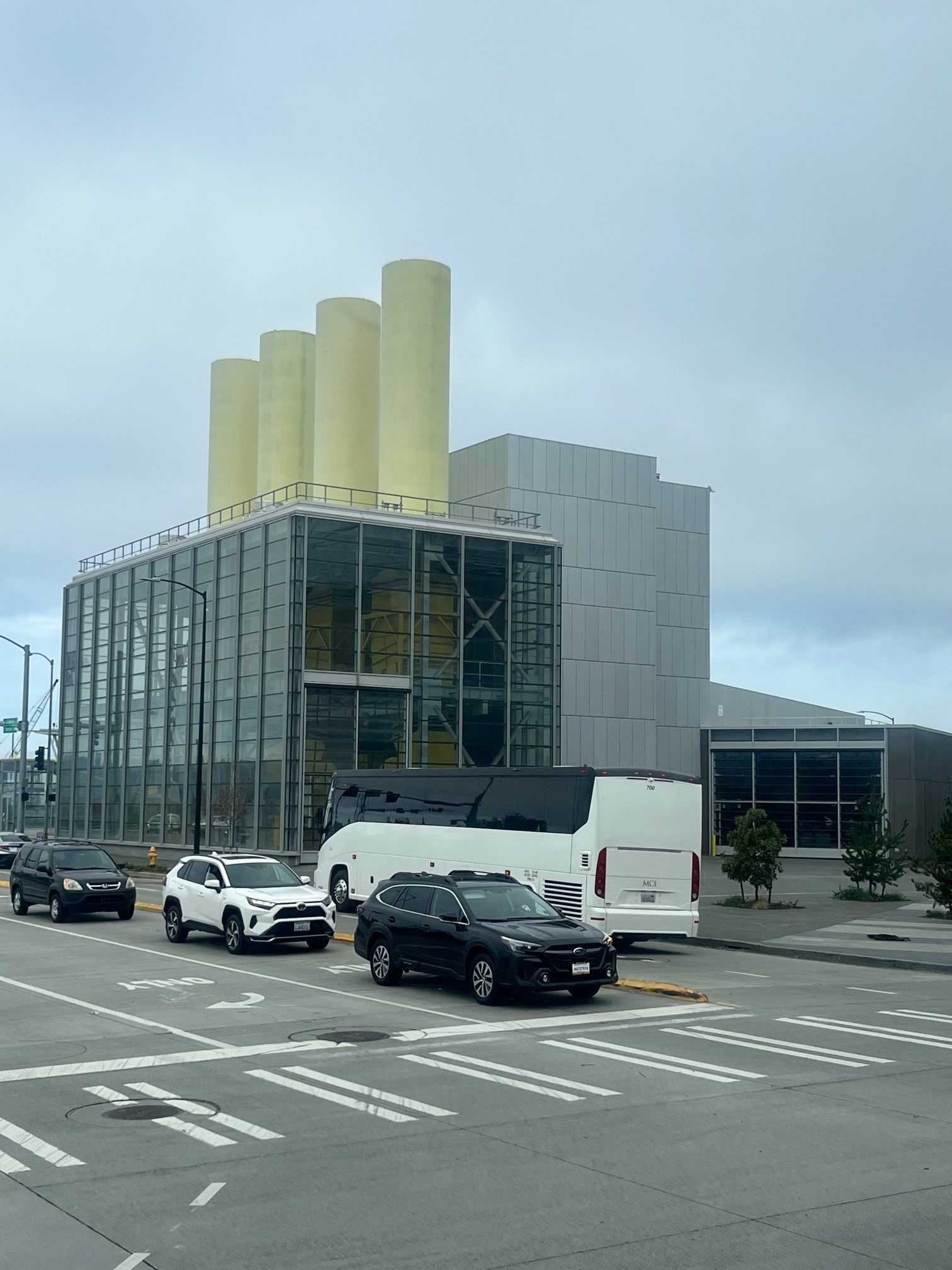
There is a constant low-level rumbling of the traffic above. As one employee said: “It’s the sound of a cash register for us” - meaning the vehicles are paying their tolls. The very slight vibrations of the traffic used to cause the bolts on the holding racks for the water drainage pipes to come loose on a regular basis. The original specifications for construction did not include washers so staff were continuously tightening the bolts – at least until they installed washers.
As well, the nature of a tunnel invert means that the ceiling will be low. In the Alaskan Way’s case, the invert’s clearance became even lower when cross-pipes were installed to connect with the main drainage piping. To move equipment and people around on the fleet of Cushman utility vehicles staff had to create “divets”, or small dips, in the concrete floors underneath any cross-piping.
The tunnel floor is kept spotless and there are no rodents because, simply, there is no food. There is, though, from time to time, an errant human found in the tunnel. Staff are often sent on a tour down the tunnel first thing in the morning to see if anybody has crept inside overnight.
Despite being made of 1,400 concrete rings, the bored tunnel is very much water-tight, except for small leakages around the start at both ends. This is where the Omega joint is located which connects the cut-and-cover entry and exit sections with the beginning of the bored tunnel structure and its connecting rings. Light pumping duties keep the omega joints dry enough.
Meanwhile, inside the main electrical room, it’s “please don’t touch any buttons”. The supplying local power company may consider its customer only a “medium voltage” client, but there is still 26,000V running into the system. This is stepped down onsite at each of the two main buildings (where the fast-extraction fans are located) to 480V for general use. The two buildings share the tunnels power needs. If one site goes down, the other site can supply the stricken one with power within five seconds.
Strangely, the 5,700 lights for the tunnel are not LED. They remain fluorescent and high-pressure because, as at the time of design back around 2010, LED lighting was not as common as today. To replace them now would be a major technical challenge and financial outlay, although this is not ruled out. Nonetheless, the lights operate on five levels of brightness to ease the adaptation to lighting coming into the tunnel and daylight when leaving.
--------------------------------------------------------------------------------------------------------
Squares in a round
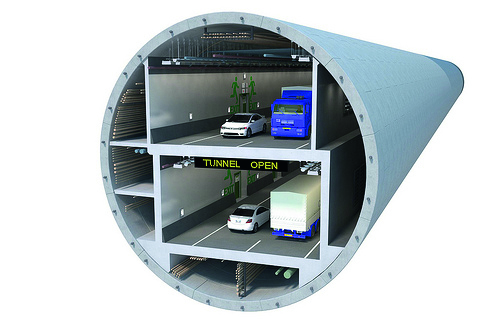
Imagine the inside of the tunnel where sits two concrete boxes, one atop the other, and their bottom surfaces – their floors - are the road surfaces. The lower box’s floor carries north-bound traffic, while the top box’s floor carries southbound traffic.
To support the two stacked boxes, the lower box sits upon concrete corbels (edges) built into the sides of the circular tunnel. This creates, underneath the floor of the bottom box, the invert, the lowest section of a tunnel that acts as the tunnel’s floor running the length of the structure. In this case, the invert is for maintenance and holds such systems as those for drainage and power.
Running beside each concrete box is an escape section of the tunnel. There are doors running the length of each box for entry into the escape section should an emergency arise. In the event of an emergency, fans in the escape section automatically kick in to increase the section’s air pressure to that just above the road adjoining road section. This gives the escape section a positive air pressure, greater than that of the road tunnel. Smoke-filled air from the road tunnel cannot then enter the escape section as the flow of air will be from into the main road tunnel.





